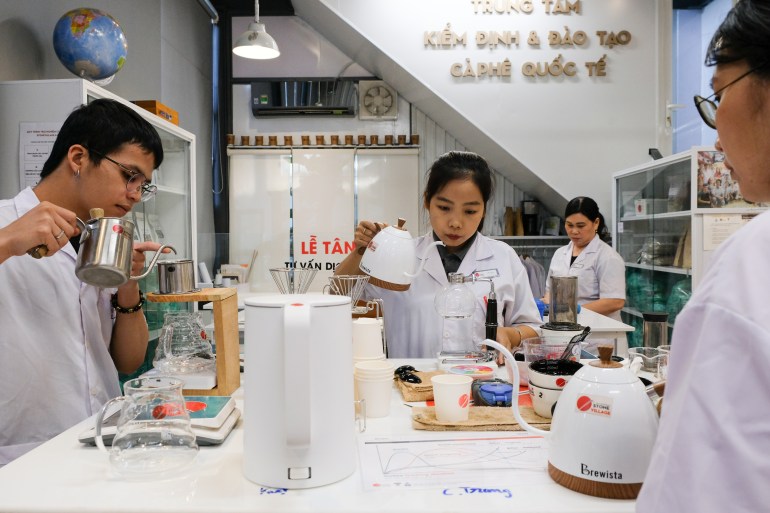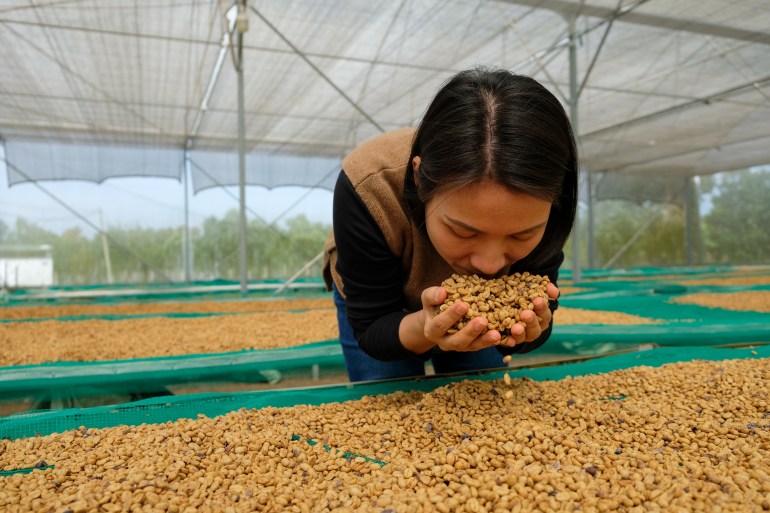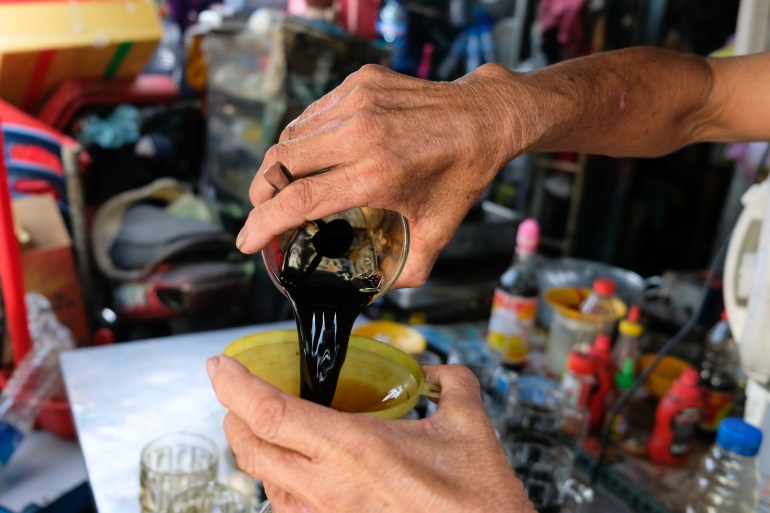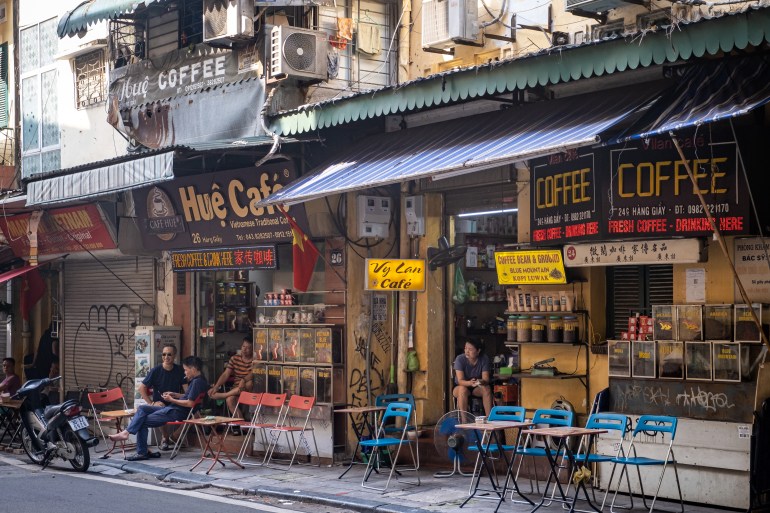Buon Ma Thuot, Vietnam – The white-walled room in a home on the outskirts of Buon Ma Thuot, Vietnam’s espresso capital, is quiet. The one factor breaking the silence is the occasional beep of an digital scale, or the sound of espresso being poured right into a measuring glass. A handful of individuals, all sporting white lab coats, think about their work.
“That is actually a lab,” says Nguyen Van Hoa, as he walks across the room within the white lab coat he wears over his denims and trainers. A younger man, Hoa calls himself a “inexperienced bean hunter” and is the proprietor of Stone Village Lab and Training, an organization that researches and sources high-quality espresso beans for cafes and low companies.
At times, he stops at a desk to exhibit what number of beans so as to add to every cup and the best water temperature. Baristas and cafe homeowners come right here from everywhere in the nation to find out about espresso, from the capital Hanoi within the north to Ho Chi Minh Metropolis within the south.
He holds out a cup with a small serving of darkish brown espresso brewed from a mix he has been engaged on for seven years. “It’ll change the thoughts of anybody who thinks that you just can’t make good espresso from Robusta,” he says.
This – altering the minds of the numerous Robusta sceptics – is what has occupied Nguyen Van Hoa for the previous few years. Within the espresso business, Robusta is called the inferior sibling of Arabica, missing the latter’s complexity and sweeter, smoother notes. Robusta is sort of at all times mass-produced and low-cost.
“The Robusta market is simply searching for the perfect worth. However we will change that,” Nguyen Van Hoa says.
They have to. The Arabica espresso bean which is near-universally synonymous with high quality espresso, is beneath critical risk from local weather change. Reforming the picture and high quality of the much-maligned – however, as its title suggests, resilient – Robusta espresso bean is essential for the way forward for espresso.
And Vietnam is the place that change could properly occur. It’s the world’s largest producer of Robusta – and second to Brazil in total espresso manufacturing, and the bean includes 95-97 % of all of the espresso grown within the nation.
This has been the case since French colonists introduced espresso vegetation to the area within the 1850s.
“The concept was to ‘simply deliver the beans and the extra you deliver the extra [money] you make’,” explains Timen Swijtink, managing companion on the espresso firm Lacaph in Ho Chi Minh Metropolis.
Within the a long time that adopted, espresso plantations grew in reputation. After Vietnam’s first business espresso processing plant was in-built 1950, the business continued to broaden.
Then, in 1986, Vietnam launched Doi Moi (“reinvention”), which shifted the nation’s post-war financial focus to be extra market oriented. Since then, the nation’s annual espresso bean manufacturing has exploded, up from 18,400 tonnes to greater than 1.9 million tonnes.
Right this moment, 90 % of Vietnam’s espresso is grown round Buon Ma Thuot, on the Central Highlands plateau, between 500 metres (1,640 toes) and 800 metres (2,625 toes) above sea stage. Right here, in each path, huge fields of vivid inexperienced espresso vegetation stretch into the horizon. Within the autumn, the small cherries, that are concerning the measurement of grapes and develop in bunches, overwhelm the branches and alter from inexperienced to crimson – an indication that they’re prepared for harvest.

‘The vegetation are blissful collectively’
Simply south of Buon Ma Thuot, not removed from Nguyen Van Hoa’s espresso lab, is the Aeroco espresso plantation – eight hectares in measurement (20 acres) – which Anh Nguyen Tu and her husband, Le Dinh Tu, have run since 2017.
High quality just isn’t prime of the listing for the large, multinational corporations that flip the vast majority of Vietnam’s espresso beans into instantaneous espresso for the delicate drink and pharmaceutical corporations that use caffeine of their merchandise. Each purchase beans cheaply and in bulk.
However at Aeroco, the main focus may be very a lot on rising “positive” Robusta. Le Dinh Tu is an agricultural engineer. Earlier than shifting to specialty espresso, the couple supplied natural fertilisers to farmers for 18 years.
“It took three years till we may survive from espresso, there are various prices concerned if you wish to work in a sustainable method,” says Anh Nguyen Tu.
Carrying a straw hat as safety from the afternoon solar, she walks out among the many vegetation. She explains the rising course of. “We develop in three layers. First grass, then espresso, then timber like jackfruit and pepper. That is to steadiness the ecosystem. The vegetation are blissful collectively,” she says.
Planting this fashion advantages each the bushes and the land. It offers the espresso plant much-needed shade, and helps the soil retain its vitamins.

Anh Nguyen Tu picks and thoroughly scratches a pale crimson cherry together with her nail to find out whether it is absolutely ripe. If the beans are harvested too early, the espresso is not going to have the spherical and candy aftertaste typical for high quality espresso. “These cherries want a bit extra time,” she says, then walks in direction of an open house the place a bunch of staff are gathering beans which had been laid out on canvases within the solar.
It’s a time-consuming course of. To correctly dry and ferment the beans, they have to be turned each half-hour, after which introduced indoors within the afternoon. “I had no concept how affected person you have to be when rising espresso,” says Pham Thi Duyen, one of many employees. She wears a inexperienced shirt, identical to the others within the group, most of whom are girls.
“I realise it now, when doing it with my very own arms,” she says.
Most espresso grown at Aeroco is Robusta. The couple additionally runs a smaller Arabica plantation in Kon Tum, a few hours away, at a barely larger altitude. Arabica vegetation want extra elevation than Robusta bushes to develop properly: a minimum of about 800 metres (2,625 toes) above sea stage, however ideally larger, as much as 1,500 metres (5,000 toes). At such altitudes, the air is cooler, and the beans develop extra slowly, which permits time to develop extra flavour.
Usually, Robusta beans are mass-produced. Harvesting occurs simply as soon as, which suggests many unripe and broken cherries find yourself within the combine, and the beans are then left to dry on the bottom. At Aeroco, beans are hand-picked a number of occasions to make sure that solely the ripe cherries are picked every time.
The method could decrease productiveness, “however the high quality is incomparable”, Anh Nguyen Tu says.

‘Roast it darkish, serve it sturdy’
At Cheo Leo, an iconic family-run cafe on a small backstreet in Ho Chi Minh Metropolis, a waiter brings out glass after glass with just a few centimetres of darkish, glimmering espresso.
“We roast it darkish and serve it sturdy,” he says.
Vietnam has a novel method of brewing espresso referred to as “phin”. First, a perforated metallic filter plate is positioned on prime of a glass or mug. Just a few tablespoons of finely floor beans are added to the reusable metallic brew chamber, which sits on the filter plate. A gravity chamber is pressed down on prime of the espresso, earlier than sizzling water is poured over prime. This course of permits the espresso to slowly drip downward into the glass, enhancing its flavour.
The darkish, fragrant drink might be served both sizzling (“ca phe nong”) or with ice (“ca phe da”), and sometimes with sweetened, condensed milk.
Phin espresso is with out exception created from Robusta. And since the beans are typically low high quality, they’re typically roasted with different substances – akin to butter, soy sauce, sugar or vanilla – so as to add flavour.
“This began 50-60 years in the past, when the nation was poor, and nobody may afford high quality beans. Now, individuals have gotten used to the style and nonetheless favor it,” explains Julien Nguyen, the younger proprietor of the cafe Tonkin Cottage in Ho Chi Minh Metropolis.
Till lately, this was the story of Vietnam’s Robusta. However issues are altering.
With some growers now treating the cultivation of Robusta as they’d Arabica, the bar is being raised. International locations akin to Uganda, India and Indonesia now produce specialty Robusta, with a number of varieties scoring greater than 80 factors out of 100 on the Specialty Espresso Affiliation’s chart, the business’s benchmark. Scoring 80 factors or larger on this index classifies a espresso as “specialty” and provides it a ranking of “excellent”. Increased than 85 is “wonderful” whereas scoring 90 or extra is “excellent”.

Local weather change has been an enormous issue. Robusta tolerates larger temperatures – sometimes 22 – 30 levels Celcius (72 – 86 levels Fahrenheit) – than Arabica – sometimes 15C – 20C (59 – 68F) – and is extra immune to illness, bugs and funguses. Research have proven that by 2050 as a lot as 50 % of the land used to develop Arabica immediately is perhaps unsuitable for manufacturing.
The worldwide espresso business should rework itself – meaning rising Robusta in new areas and producing a higher-quality product.
“The business understands this. However it is usually in shock,” says Juan Pablo Solis, senior adviser on local weather change and surroundings at Fairtrade Worldwide, which helps farmers and employees obtain higher working situations and truthful worth for his or her merchandise. “Everyone seems to be making an attempt to arrange themselves for these challenges.”
Espresso’s world panorama could change. “Espresso is a fragile plant that requires a sure micro-climate to thrive. Sooner or later, it’ll disappear from some international locations,” explains Solis.
“Individuals will nonetheless demand espresso and a few international locations will proceed producing decrease high quality espresso in large volumes,” Solis says. Nevertheless, he provides, there may also be smaller plantations targeted on producing high-quality espresso.
Analysis by International Change Biology, the environmental change journal, exhibits that manufacturing of Arabica is predicted to say no by 50 % by 2088 due to rising world temperatures.
The world is already seeing indicators of this. Extreme drought in Brazil in 2021, for instance, reduce the annual crop that yr by one-third.
Robusta might be extra resilient to the results of local weather change – though specialists warning that extra analysis is required to know its limitations.

Altering the espresso ‘expertise’
Some cafe homeowners in Vietnam say there’s already a rising demand for higher-end espresso from youthful drinkers. “Specialty espresso is a youth tradition right here,” says Luong Hanh, the supervisor of Soul Espresso in Buon Ma Thuot. Carrying an outsized white shirt, she sits on the lengthy bar on the centre of the ethereal cafe, which has drinks like lychee- or guava-flavoured chilly brew on the menu.
Moreover drinks brewed with Arabica, it additionally serves espresso made with native Robusta beans.
“We wish to see extra positive Robusta in Vietnam. Previously, it was bitter and never excellent. Now, we will discover beans that had been picked when ripe and stored in the fitting temperature and humidity,” she says.
“Individuals who like specialty espresso normally say that Robusta is bitter and has a too-heavy physique. However they’re altering their minds after espresso retailers began serving good Robusta,” she says.
It’s additionally concerning the espresso expertise. At SHIN Heritage in Ho Chi Minh Metropolis, iced espresso is served in outsized wine glasses to a enterprise crowd. At 43 Manufacturing facility Espresso Roaster, in the identical metropolis, a large artwork set up on the entrance simulates a chook’s view of espresso plantations. And Lacaph, one other cafe in Ho Chi Minh Metropolis, holds workshops for java fanatics on the historical past of Vietnamese espresso.
Previously 5 years, espresso consumption in Asia has elevated by 1.5 % – thrice greater than in Europe.
This has benefitted native gamers in Vietnam. As a substitute of Starbucks or Costa Espresso, native giants Phuc Lengthy or Highlands Espresso occupy prime areas. Starbucks has just one outlet per a million individuals in Vietnam, in distinction to neighbouring Thailand or Malaysia, the place the chain has between six and 11 shops per a million individuals.
Vietnamese espresso is rising overseas, too. Cong Caphe, a well-liked chain styled with Vietcong memorabilia, has shops in Seoul, Kuala Lumpur and, as of final yr, Toronto.
Again in Buon Ma Thuot, Nguyen Van Hoa takes out a e-book from considered one of her cabinets – the World Atlas of Espresso, which has a chapter on Vietnam. “This e-book modified my thoughts. It says that Vietnamese espresso is unhealthy, which made me wish to change the picture of our espresso,” he says. “I wish to present that it’s doable to make nice phin. It’s our custom,” he says.
However no rush. Change is a sluggish course of, he says. Similar to brewing phin espresso.

